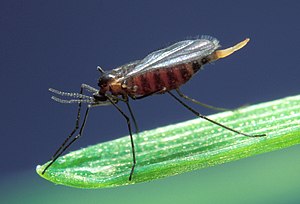Hessen fly
| Hessen fly | ||||||||||||
|---|---|---|---|---|---|---|---|---|---|---|---|---|

Hessen fly ( Mayetiola destructor ) |
||||||||||||
| Systematics | ||||||||||||
|
||||||||||||
| Scientific name | ||||||||||||
| Mayetiola destructor | ||||||||||||
| ( Say , 1817) |
The Hessen fly ( Mayetiola destructor ), also known as Hessen mosquito, rye gall mosquito or grain devastator , belongs to the gall mosquito family (Cecidomyiidae) and is one of the most important pests in cereal cultivation, especially on wheat, barley and rye. Unlike typical gall midges, their larvae do not produce galls , but rather parasitize in the stalks of grasses (cereals and wild grasses).
Thomas Jefferson first described the Hessen fly in 1792, and Thomas Say gave it the scientific name in 1817.
features
The Hessen fly is 2.7 to 3.7 millimeters long, velvety black, blood-red on the abdomen, between the abdominal rings and on a center line of the back and hairy reddish yellow on the antennae. The wings appear gray through short hairs. The legs are very long. The much rarer male is three millimeters long, less intensely colored and reddish-yellow and only has black hair on the wings.
development
In Central Europe, the adults appear in late April to early May. The dark females lay about 150 to 300 brown-red, cylindrical, 0.3 millimeter long eggs individually or in small groups on the leaf surface of the host plant over two to three days. After about five days, the larvae hatch and penetrate the host plant between the stalk and the leaf sheath. They secrete a salivary secretion, which dissolves the cell walls of the plants, and absorb the sap. Above the sucking point, the plant reacts with yellowing, dries up or rots. In strong winds, the stalk breaks above the infected areas. After about four weeks, the larvae pupate at the suckling point. The second generation of mosquitoes appears at the end of July. The animals overwinter as a prepupa in the stalk or in the ground. Under ideal climatic conditions (outside Europe) up to five generations can be formed in one year.
Occurrence
Originally from Asia, it was first brought to Europe with the grain cultivation and from there to North America, New Zealand and Australia. The name "Hessian Fly" was given to the mosquito in North America. It was wrongly assumed that she came across the Atlantic with the sleeping straw of Hessian mercenary troops during the fighting at the time of the American independence movement (1775–83).
literature
- K. Günther, H.-J. Hannemann, F. Hieke, E. Königsmann & H. Schuman: Urania animal kingdom - insects. Urania-Verlag, Leipzig, Jena 1994, ISBN 3-332-00498-0
- RC Dahlberg: Observations on the occurrence of the real 'Hessen fly' Mayetiola destructor (Say). In northern Germany . 1916.
swell
- ↑ Michael Chinery: Insects Central Europe , 3rd ed. 1984, p. 202
- ↑ a b Gall mosquitoes . In: Meyers Konversations-Lexikon . 4th edition. Volume 6, Verlag des Bibliographisches Institut, Leipzig / Vienna 1885–1892, p. 866.
- ↑ Lucia C. Stanton: Thomas Jefferson Encyclopedia: Hessian Fly. In: Thomas Jefferson's Monticello. Thomas Jefferson Foundation, November 1991, accessed on January 22, 2019 (English): “His chance came in June of 1792, when he was given a second batch of pupating Hessian flies (the fate of the first is unknown). For two weeks he watched over the flaxseed-like chrysalises, was present at their "hatching," observed an adult fly laying her eggs, and recorded details of a minute anatomy - presumably with the aid of a microscope, as the fly was "between the size of a gnat & musketoe. " He recorded the eight saffron-colored "annuli" on its abdomen, its two "moniliform" antennae, and two "balances like the plectrum of the sticcada," a keyed instrument he had seen Benjamin Franklin play in France. "
Web links
- Mayetiola destructor in Fauna Europaea